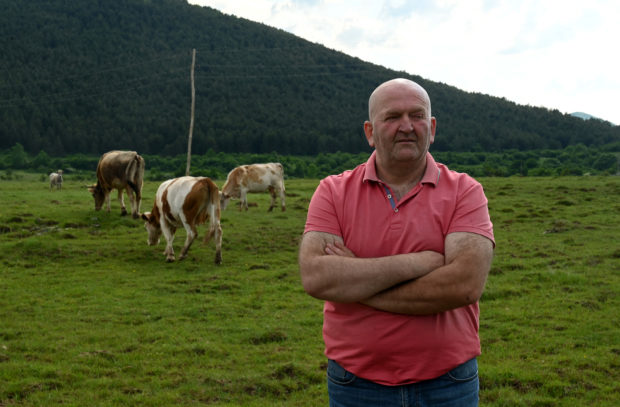‘It’s a plague’: Croatian farmers incensed by wolf attacks

Ivan Tesija farmer and head of an association of 1,500 farmers poses beside his grazing cattle in Udbina, central Lika region of Croatia, on June 8, 2021. AFP
UBDINA, Croatia — The wolf corpse hanging from a road sign outside a small Croatian town warned that farmers had been pushed too far — attacks on their livestock were driving them to desperation.
Nobody knows who strung up the wolf, but the incident in April came just days after a local farmer saw roughly 90 of his sheep slaughtered by wolves.
Images of bloodied sheep carcasses were splashed across the newspapers and social media, shocking many and prompting increasingly strident calls from farmers for a cull on the predators.
“It’s simply a plague,” says Ivan Tesija, a cattleman.
“Wolves are everywhere, they are fearless, and people don’t know how to defend themselves.”
Article continues after this advertisementThe animals have been protected by law since 1995 when they were on the verge of disappearing.
Article continues after this advertisementAlthough a culling quota was allowed from 2005, ministers reintroduced the complete ban in 2013 to protect dwindling numbers.
The prohibition is strongly backed by animal protection groups.
“We are the ones who created this mess, so we should be the ones to solve it and not make wolves pay for our mistakes,” says Luka Oman, head of the Animal Friends NGO.
Wolf-dog threat
Almost 3,000 domestic and farm animals — primarily sheep — were killed or injured by wolves last year, slightly above average, according to official figures.
About 160 wolves roam sparsely populated areas from the Adriatic coast hinterland to the mountains on the borders with Slovenia and Bosnia, the economy ministry estimates.
But farmers and hunters say the real figure is around 300. Too many, they say, for the habitat of 25,000 square kilometers (9,652 square miles).
The situation is complicated further by the presence of wolf-dog hybrids — estimated by scientists at some 10 percent of the current population.
“Hybrids are a huge problem — they are fearless, lack natural hunting instinct and go for easier prey,” says veterinarian and hunter Boris Katic.
This means cattle or sheep rather than boars or deer, he explains.
Katic says some locals bred the animals as a hobby in the time of Croatia’s 1990s independence war and its aftermath.
Josip Kusak from Zagreb University points out, though, that hybrid populations explode when male wolves are being killed, forcing females to mate with stray dogs.
But, they agree that wolf-dogs are bad news for the wolf genome.
Katic says all hybrids, that according to him could make up around a quarter of the current wolf population, should be killed and then a culling quota be reintroduced.
But the economy ministry said the number of wolves had “significantly decreased” when the quota was allowed before 2013, and culling did nothing to reduce attacks on livestock.
Experts and animal protection groups say farmers can thwart attacks with better electric fencing, herding their animals at night and monitoring them during the day.
The number of attacks “does not reflect the number of wolves but rather how many poorly kept cattle there are”, says Kusak.
Unendurable torments
The issue is not only scientific. It has strong emotional and economic elements.
The farmers feel that their livelihoods are on the line.
“These are torments no one can endure,” Kosa Galovic tells AFP, recounting how six wolves killed three of her sheep and five lambs last month, imperiling her finances.
Ivan Tesija says roughly 100 of his cows have been slaughtered over the past 12 years, and showed a picture of a calf that died in a recent attack.
The government offers compensation ranging from about 80 euros ($95) for a sheep or a goat carcass to 10 times that amount for a pregnant cow — amounts dismissed as paltry by Tesija.
Animal protection groups, though, see it as a wider issue of humanity’s relations with nature.
“The co-existence of humans and wolves is not only possible, it is necessary,” says Luka Oman.
“If we want to preserve a genuine natural environment, it must contain wild animals too.”
He argues that hunting could make the situation worse for farmers because killing a dominant male or female can destabilise the pack and lead to more attacks — a view shared by the ministry.
But his appeals are unlikely to sway beleaguered farmers.
“You never know what the night will bring, people feel terrorized,” Josip Subaric says, telling AFP that two of his calves were killed by wolves last month despite electric fencing.
“In our business, the wolf is the master of life and death.”